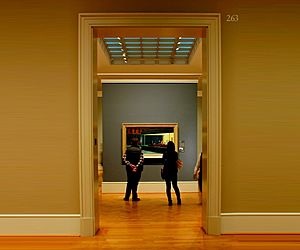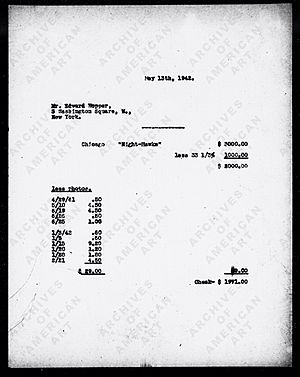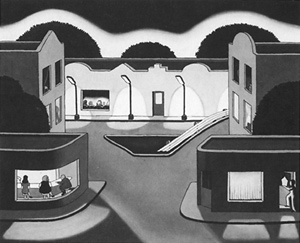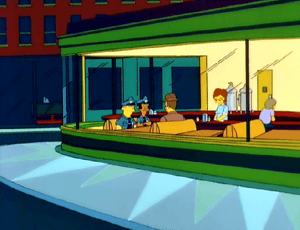Nighthawks (Hopper) facts for kids
Quick facts for kids Nighthawks |
|
|---|---|
 |
|
| Artist | Edward Hopper |
| Year | 1942 |
| Medium | oil paint, canvas |
| Movement | American realism |
| Dimensions | 84.1 cm (33.1 in) × 152.4 cm (60.0 in) |
| Location | Art Institute of Chicago |
| Accession No. | 1942.51 |
Nighthawks is a 1942 oil on canvas painting by Edward Hopper that portrays four people in a downtown diner late at night as viewed through the diner's large glass window. The light coming from the diner illuminates a darkened and deserted urban streetscape. The bartender may be a soda jerker, the three guests are night owls, giving the painting the title.
It has been described as Hopper's best-known work and is one of the most recognizable paintings in American art. Within months of its completion, it was sold to the Art Institute of Chicago on May 13, 1942, for $3,000.
Contents
About the painting

It has been suggested that Hopper was inspired by a short story of Ernest Hemingway's, either "The Killers" (1927), which Hopper greatly admired, or from the more philosophical "A Clean, Well-Lighted Place" (1933). In response to a query on loneliness and emptiness in the painting, Hopper outlined that he "didn't see it as particularly lonely". He said "unconsciously, probably, I was painting the loneliness of a large city".
Ownership history
Upon completing the canvas in the late winter of 1941–42, Hopper placed it on display at Rehn's, the gallery at which his paintings were normally placed for sale. It remained there for about a month. On St. Patrick's Day, Edward and Jo Hopper attended the opening of an exhibit of the paintings of Henri Rousseau at New York's Museum of Modern Art, which had been organized by Daniel Catton Rich, the director of the Art Institute of Chicago. Rich was in attendance, along with Alfred Barr, the Museum of Modern Art director. Barr spoke enthusiastically of Gas, which Hopper had painted a year earlier, and "Jo told him he just had to go to Rehn's to see Nighthawks. In the event, it was Rich who went, pronounced Nighthawks 'fine as a [Winslow] Homer', and soon arranged its purchase for Chicago." The sale price was $3,000 (equivalent to $53,730 in 2022).
Location of the restaurant
The scene was supposedly inspired by a diner (since demolished) in Greenwich Village, Hopper's neighborhood in Manhattan. Hopper himself said the painting "was suggested by a restaurant on Greenwich Avenue where two streets meet". Additionally, he noted that "I simplified the scene a great deal and made the restaurant bigger".
That reference has led Hopper fans to engage in a search for the location of the original diner. The inspiration for the search has been summed up in the blog of one of these searchers: "I am finding it extremely difficult to let go of the notion that the Nighthawks diner was a real diner, and not a total composite built of grocery stores, hamburger joints, and bakeries all cobbled together in the painter's imagination".
The spot usually associated with the former location is a now-vacant lot known as Mulry Square, at the intersection of Seventh Avenue South, Greenwich Avenue, and West 11th Street, about seven blocks west of Hopper's studio on Washington Square. However, according to an article by Jeremiah Moss in The New York Times, that cannot be the location of the diner that inspired the painting because a gas station occupied that lot from the 1930s to the 1970s.
Moss located a land-use map in a 1950s municipal atlas showing that "Sometime between the late '30s and early '50s, a new diner appeared near Mulry Square". Specifically, the diner was located immediately to the right of the gas station, "not in the empty northern lot, but on the southwest side, where Perry Street slants". That map is not reproduced in the Times article but is shown on Moss's blog.
Moss concludes that Hopper should be taken at his word: the painting was merely "suggested" by a real-life restaurant, he had "simplified the scene a great deal", and he "made the restaurant bigger". In short, there probably never was a single real-life scene identical to the one that Hopper had created, and if one did exist, there is no longer sufficient evidence to pin down the precise location. Moss concludes, "the ultimate truth remains bitterly out of reach".
In popular culture
Because it is so widely recognized, the diner scene in Nighthawks has served as the model for many homages and parodies.
Painting and sculpture
Many artists have produced works that allude to or respond to Nighthawks.
Hopper influenced the Photorealists of the late 1960s and early 1970s, including Ralph Goings, who evoked Nighthawks in several paintings of diners. Richard Estes painted a corner store in People's Flowers (1971), but in daylight, with the shop's large window reflecting the street and sky.
More direct visual quotations began to appear in the 1970s. Gottfried Helnwein's painting Boulevard of Broken Dreams (1984) replaces the three patrons with American pop culture icons Humphrey Bogart, Marilyn Monroe, and James Dean, and the attendant with Elvis Presley. According to Hopper scholar Gail Levin, Helnwein connected the bleak mood of Nighthawks with 1950s American cinema and with "the tragic fate of the decade's best-loved celebrities." Nighthawks Revisited, a 1980 parody by Red Grooms, clutters the street scene with pedestrians, cats, and trash. A 2005 Banksy parody shows a fat soccer hooligan in Union Flag boxers standing outside the diner, apparently having just smashed the diner window with a nearby chair.
A large mural recreation of Nighthawks was painted on a defunct Chinese restaurant in Santa Rosa, California until the building was demolished in 2019.
Literature
Several writers have explored how the customers in Nighthawks came to be in a diner at night, or what will happen next. Wolf Wondratschek's poem "Nighthawks: After Edward Hopper's Painting" imagines the man and woman sitting together in the diner as an estranged couple: "I bet she wrote him a letter/ Whatever it said, he's no longer the man / Who'd read her letters twice." Joyce Carol Oates wrote interior monologues for the figures in the painting in her poem "Edward Hopper's Nighthawks, 1942". A special issue of Der Spiegel included five brief dramatizations that built five different plots around the painting. Erik Jendresen and Stuart Dybek also wrote short stories inspired by this painting.
Film
Hopper was an avid moviegoer and critics have noted the resemblance of his paintings to film stills. Nighthawks and works such as Night Shadows (1921) anticipate the look of film noir, whose development Hopper may have influenced.
Hopper was an acknowledged influence on the film musical Pennies from Heaven (1981), for which production designer Ken Adam recreated Nighthawks as a set. Director Wim Wenders recreated Nighthawks as the set for a film-within-a-film in The End of Violence (1997). Wenders suggested that Hopper's paintings appeal to filmmakers because "You can always tell where the camera is." In Glengarry Glen Ross (1992), two characters visit a café resembling the diner in a scene that illustrates their solitude and despair. The painting was also briefly used as a background for a scene in the animated film Heavy Traffic (1973) by director Ralph Bakshi.
Nighthawks also influenced the "future noir" look of Blade Runner; director Ridley Scott said "I was constantly waving a reproduction of this painting under the noses of the production team to illustrate the look and mood I was after". In his review of the 1998 film Dark City, Roger Ebert noted that the film had "store windows that owe something to Edward Hopper's Nighthawks." Hard Candy (2005) acknowledged a similar debt by setting one scene at a "Nighthawks Diner" where a character purchases a T-shirt with Nighthawks printed on it.
The painting features in the 2009 movie Night at the Museum: Battle of the Smithsonian, where it is erroneously shown to be a part of the Smithsonian. The painting comes to life in the film through CGI animation with all the characters briefly reacting to the events in the outside world.
Music
- Tom Waits's album Nighthawks at the Diner (1975) features a title, a cover, and lyrics inspired by Nighthawks.
- The video for Voice of the Beehive's song "Monsters and Angels", from Honey Lingers, is set in a diner reminiscent of the one in Nighthawks, with the band-members portraying waitstaff and patrons. The band's web site said they "went with Edward Hopper's classic painting, Nighthawks, as a visual guide."
- Orchestral Manoeuvres in the Dark's 2013 single "Night Café" was influenced by Nighthawks and mentions Hopper by name. Seven of his paintings are referenced in the lyrics.
Theatre and opera
- Jonathan Miller's 1982 production of Verdi's opera Rigoletto for English National Opera, set in 1950s New York, designed by Patrick Robertson and Rosemary Vercoe, features one street setting with a bar inspired by the Nighthawks diner.
Television
- The television series CSI: Crime Scene Investigation placed its characters in a version of the painting.
- The television show Fresh Off the Boat Season 2 poster features the title family in Nighthawks with actress Constance Wu using chopsticks.
- The closing scene of Turner Classic Movies (TCM)'s “Open All Night” intro sequence, which was used to open overnight movie presentations from 1994 to 2021, is based on Nighthawks.
- The American television series Shameless features the Nighthawks painting, in a late season 11 arc where Frank pulls off his final "ICOE" heist.
- In an episode of That 70's Show entitled Drive In, Red and Kitty, having been thrown out of a new TGI Fridays style restaurant Kitty had talked Red into taking her to, end up going to Red's favorite place to eat, called Phillies, which a disappointed Kitty finds too 'familiar'. The camera pulls out to reveal they're in the actual painting.
Scale model
A number of model railroaders, most notably John Armstrong, have recreated the scene on their layouts.
The theater lighting manufacturer Electronic Theatre Controls has a human-sized scale model of the diner in the lobby of their headquarters in Middleton, Wisconsin. It is used as a reception area for the building.
Parodies
Nighthawks has been widely referenced and parodied in popular culture. Versions of it have appeared on posters, T-shirts and greeting cards as well as in comic books and advertisements. Typically, these parodies—like Helnwein's Boulevard of Broken Dreams, which became a popular poster—retain the diner and the highly recognizable diagonal composition but replace the patrons and attendant with other characters: animals, Santa Claus and his reindeer, or the respective casts of The Adventures of Tintin or Peanuts.
One parody of Nighthawks even inspired a parody of its own. Michael Bedard's painting Window Shopping (1989), part of his Sitting Ducks series of posters, replaces the figures in the diner with ducks and shows a crocodile outside eying the ducks in anticipation. Poverino Peppino parodied this image in Boulevard of Broken Ducks (1993), in which a contented crocodile lies on the counter while four ducks stand outside in the rain.
See also
 In Spanish: Nighthawks para niños
In Spanish: Nighthawks para niños




